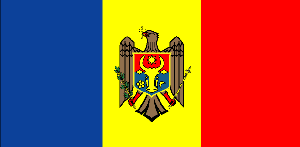
|

Moldova
Background:
Formerly ruled by Romania, Moldova became part of the Soviet Union at the close
of World War II. Although independent from the USSR since 1991, Russian forces
have remained on Moldovan territory east of the Dniester River supporting the
Slavic majority population, mostly Ukrainians and Russians, who have proclaimed
a "Transnistria" republic. One of the poorest nations in Europe, Moldova became
the first former Soviet state to elect a Communist as its president in 2001.
Location:
Eastern Europe, northeast of Romania.
Area: Total: 33,843 sq km, water: 472 sq km, land: 33,371 sq km.
Area - comparative: Slightly larger than Maryland.
Land boundaries: Total: 1,389 km, border countries: Romania 450 km, Ukraine
939 km.
Coastline: 0 km (landlocked).
Climate and Terrain:
Climate: Moderate winters, warm summers.
Terrain: Rolling steppe, gradual slope south to Black Sea.
Natural resources: Lignite, phosphorites, gypsum, arable land, limestone.
People:
Population: 4,434,547.
Ethnic groups: Moldavian/Romanian 64.5%, Ukrainian 13.8%, Russian 13%, Jewish
1.5%, Bulgarian 2%, Gagauz and other 5.2% (1989 est.) note: internal disputes
with ethnic Slavs in the Transnistrian region.
Religions: Eastern Orthodox 98.5%, Jewish 1.5%, Baptist (only about 1,000
members).
Languages: Moldavian (official, virtually the same as the Romanian language),
Russian (official), Gagauz (a Turkish dialect).
Government:
Government type: Republic.
Capital: Chisinau.
Independence: 27 August 1991 (from Soviet Union).
Economy overview:
Moldova enjoys a favorable climate and good farmland but has no major mineral
deposits. As a result, the economy depends heavily on agriculture, featuring
fruits, vegetables, wine, and tobacco. Moldova must import all of its supplies
of oil, coal, and natural gas, largely from Russia. Energy shortages
contributed to sharp production declines after the breakup of the Soviet Union
in 1991. As part of an ambitious reform effort, Moldova introduced a
convertible currency, freed all prices, stopped issuing preferential credits to
state enterprises, backed steady land privatization, removed export controls,
and freed interest rates. Yet these efforts could not offset the impact of
political and economic difficulties, both internal and regional. I
GDP - composition by sector: Agriculture: 28%, industry: 21%, services: 51%.
Return to Visiting Locations
|
|
Statistics:
Telephones - main lines in use: 627,000.
Telephones - mobile cellular: 2,200.
Radio broadcast stations: AM 7, FM 50, shortwave 3.
Radios: 3.22 million.
Television broadcast stations: 1 (plus 30 repeaters).
Televisions: 1.26 million.
Internet users: 15,000.
Railways: Total: 1,328 km.
Highways: Total: 20,000 km, paved: 13,900 km, unpaved: 6,100 km (these roads
are made of unstabilized earth and are difficult to negotiate in wet weather).
Airports: 30, with paved runways: 7, with unpaved runways: 23.
|

